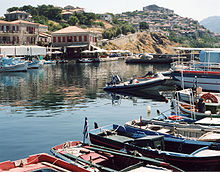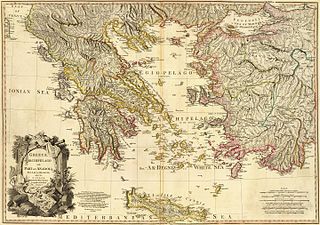
This is a timeline of ancient Greece from its emergence around 800 BC to its subjection to the Roman Empire in 146 BC.
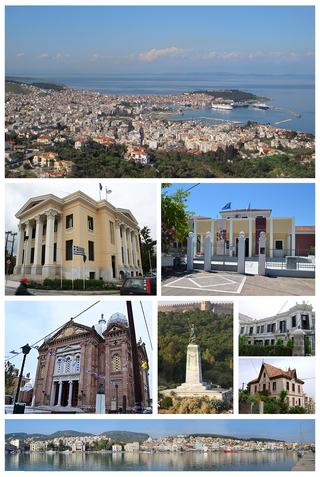
Mytilene is the capital of the Greek island of Lesbos, and its port. It is also the capital and administrative center of the North Aegean Region, and hosts the headquarters of the University of the Aegean. It was founded in the 11th century BC.
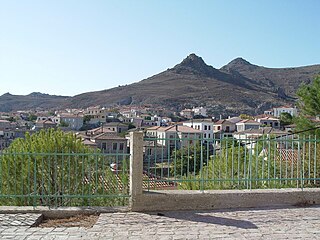
Eresos and its twin beach village Skala Eresou are located in the southwest part of the Greek island of Lesbos. They are villages visited by considerable numbers of tourists. From 1999 until 2010, Eresos and the village of Antissa constituted the municipality of Eresos-Antissa. From 2010 until 2019, Eresos was part of the municipality of Lesvos and from 2019 it is part of the municipality of West Lesvos.

Lesbos or Lesvos is a Greek island located in the northeastern Aegean Sea. It has an area of 1,633 km2 (631 sq mi), with approximately 400 kilometres of coastline, making it the third largest island in Greece and the eighth largest in the Mediterranean. It is separated from Asia Minor by the narrow Mytilini Strait. On the southeastern coast is the island's capital and largest city, Mytilene (Μυτιλήνη), whose name is also used for the island as a whole. Lesbos is a separate regional unit with the seat in Mytilene, which is also the capital of the larger North Aegean region. The region includes the islands of Lesbos, Chios, Ikaria, Lemnos, and Samos. The total population of the island was 83,755 in 2021. A third of Lesbians live in the capital, while the remainder are concentrated in small towns and villages. The largest are Plomari, Kalloni, the Gera Villages, Agiassos, Eresos, and Molyvos.

Antissa was a city of the island Lesbos (Lesvos), near to Cape Sigrium, the western point of Lesbos. The place had a harbour. The ruins found by Richard Pococke at Calas Limneonas, a little NE. of cape Sigri, may be those of Antissa. This place was the birthplace of Terpander, who is said to be the inventor of the seven-stringed lyre. According to the local historian Myrsilus of Methymna, local tradition held that the head of Orpheus had floated south from the Hebros after he was decapitated and floated south to land on the shore of Antissan territory: the spot was marked by a tomb where, according to Myrsilus, the nightingales sang more sweetly than they did elsewhere.
Gargara was an ancient Greek city on the southern coast of the Troad region of Anatolia. It was initially located beneath Mount Gargaron, one of the three peaks of Mount Ida, today known as Koca Kaya. At some point in the 4th century BCE the settlement moved approximately 5.8 km south of Koca Kaya to a site on the small coastal plain near the modern villages of Arıklı and Nusratlı, at which point the previous site came to be known as Old Gargara. Both sites are located in the Ayvacık district of Çanakkale Province in Turkey.
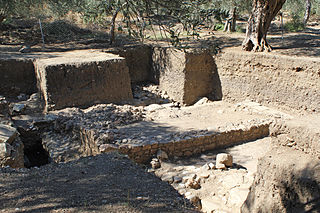
Antandrus or Antandros was an ancient Greek city on the north side of the Gulf of Adramyttium in the Troad region of Anatolia. Its surrounding territory was known in Greek as Ἀντανδρία (Antandria), and included the towns of Aspaneus on the coast and Astyra to the east. It has been located on Devren hill between the modern village of Avcılar and the town of Altınoluk in the Edremit district of Balıkesir Province, Turkey.
Agamede was a name attributed to two separate women in classical Greek mythology and legendary history.
In Greek mythology, Arisbe or Arisba may refer to the following women:
The Mytilenean revolt was an incident in the Peloponnesian War in which the city of Mytilene attempted to unify the island of Lesbos under its control and revolt from the Athenian Empire. In 428 BC, the Mytilenean government planned a rebellion in concert with Sparta, Boeotia, and certain other cities on the island, and began preparing to revolt by fortifying the city and laying in supplies for a prolonged war. These preparations were interrupted by the Athenian fleet, which had been notified of the plot, and the Mytileneans sent representatives to Athens to discuss a settlement, but simultaneously dispatched a secret embassy to Sparta to request support.

The Mytilenean Debate was an Athenian Assembly concerning reprisals against the city-state of Mytilene, which had attempted unsuccessfully to revolt against Athenian hegemony and gain control over Lesbos during the Peloponnesian War. The debate occurred in 427 BC. In the immediate aftermath of the revolt, the Athenians had decided to execute all Mytilenean men and enslave the women and children, but gathered the next day to reconsider. Thucydides reports the revolt and the resultant debate in book three of his History of the Peloponnesian War, and the opposing viewpoints concerning the warranted retributive justice are reflected in two speeches given by prominent Athenians. The events and speeches serve as an opportunity to explore the political and ideological impact of the war, and provide reflections on democracy and imperial policy.
Coes was a Greek military commander of Mytilene. He supported King Darius Hystaspes of Persia in his Scythian expedition as commander of the Mytilenaeans. Coes dissuaded the king from breaking up his bridge of boats over the Danube, and so cutting off his own retreat. For this good counsel, he was appointed by Darius on his return as the new tyrant of Mytilene.
Rhoiteion was an ancient Greek city in the northern Troad region of Anatolia, also known as Ῥοίτιον ἄκρον. Its territory was bounded to the south and west by the Simoeis river and to the east by Ophryneion. It was located on the Baba Kale spur of Çakal Tepe north of Halileli and west of İntepe in Çanakkale Province, Turkey.

Achilleion was an ancient Greek city in the south-west of the Troad region of Anatolia. It has been located on a promontory known as Beşika Burnu about 8 km south of Sigeion. Beşika Burnu is 2 km south of the modern village of Yeniköy in the Ezine district of Çanakkale Province, Turkey. The site considered in classical antiquity to be the tomb of Achilles is a short distance inland at a tumulus known as Beşiktepe. Achilleion in the Troad is not to be confused with Achilleion near Smyrna and Achilleion in the territory of Tanagra.
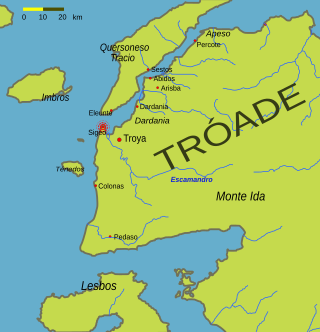
Sigeion was an ancient Greek city in the north-west of the Troad region of Anatolia located at the mouth of the Scamander. Sigeion commanded a ridge between the Aegean Sea and the Scamander which is now known as Yenişehir and is a part of the Çanakkale district in Çanakkale province, Turkey. The surrounding region was referred to as the Sigean Promonotory, which was frequently used as a point of reference by ancient geographers since it marked the mouth of the Hellespont. The outline of this promontory is no longer visible due to the alluvial activity of the Karamenderes which has filled in the embayment east of Yenişehir. The name 'Sigeion' means 'silent place' and is derived from Ancient Greek σιγή (sigē), 'silence'; in Classical Antiquity, the name was assumed to be antiphrastic, i.e. indicating a characteristic of the place contrary to reality, since the seas in this region are known for their fierce storms.
In Greek mythology, the name Mytilene may refer to one of the following figures, all of whom are counted among possible eponyms of the city Mytilene:
Lamponeia or Lamponia (Λαμπωνία), also known as Lamponium or Lamponion (Λαμπώνιον), was an Aeolian city on the southern coast of the Troad region of Anatolia. Its archaeological remains have been located above the village of Kozlu in the district of Ayvacık in Çanakkale Province in Turkey. The site was first visited by Platon de Tchiatcheff in 1849, and later surveyed and identified as Lamponeia by Joseph Thacher Clarke, the excavator of nearby Assos, in 1882, and by Walther Judeich in 1896.
In Greek mythology, Antissa was a princess of Lesbos as the daughter of King Macar and probable sister to Methymna, Mytilene, Agamede, Arisbe and Issa. Her possible brothers were Cydrolaus, Neandrus, Leucippus and Eresus. She was the eponym of the city Antissa on the said island. In some account, Antissa was claimed to be Macareus' wife instead.
In Greek mythology, Issa or Isse may refer to three people:
In Greek mythology, Macareus or Macar was an Olenian prince who became the king of the island of Lesbos.




